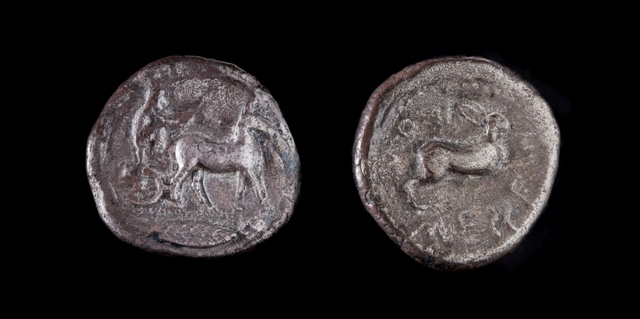Messana, Silver Tetradrachm
Dublin Core
Title
Messana, Silver Tetradrachm
Subject
Messana, originally Zancle, Sicily. Silver Tetradrachm, 470-466 BCE.
OBVERSE: Seated charioteer driving an apene, a race chariot drawn by two mules, to the right. Large laurel leave in exergue; all set in dotted border.
REVERSE: In dotted border, hare jumping right. Inscription "MESSE-N-ION" (of the Messenians) with small omikron.
OBVERSE: Seated charioteer driving an apene, a race chariot drawn by two mules, to the right. Large laurel leave in exergue; all set in dotted border.
REVERSE: In dotted border, hare jumping right. Inscription "MESSE-N-ION" (of the Messenians) with small omikron.
Description
Zancle (“sickle”), named for its sickle-shaped harbor, was conquered by Anaxilas, the tyrant of Rhegium, a city on the Italic peninsula just across the strait, in the early fifth century BCE. Anaxilas settled Messenian exiles there and the named was changed to Messana. (Messana is the Doric dialect version of Messene, a region on the Peloponnese that was dominated by Sparta).
The OBVERSE depicts a man riding an apene, or a chariot drawn by two mules. The Olympic games first held apene races in 500 BCE; but, considered too undignified, they were abolished as early as 444 BCE. Anaxilas, however, was so proud of his Olympic victory with the apene that he commemorated it with this coin type, first struck in 480 BCE. This type became so highly associated with Messana that it was kept even after the death of Anaxilas and the expulsion of his successors in 461 BCE. The laurel leaf in the exergue, the area below the chariot, represents the olive crown that was awarded to victors at the Olympic games. The symbolism of the hare is a bit more ambiguous, referring to either the speed of Anaxilas’ chariot, the fertility and abundance of the island or possibly the fact that Aristotle (quoted by Pollux, Onomasticon 5.75) claims that Anaxilas brought the hare to Sicily (as hunting hares was a popular activity for aristocrats).
The OBVERSE depicts a man riding an apene, or a chariot drawn by two mules. The Olympic games first held apene races in 500 BCE; but, considered too undignified, they were abolished as early as 444 BCE. Anaxilas, however, was so proud of his Olympic victory with the apene that he commemorated it with this coin type, first struck in 480 BCE. This type became so highly associated with Messana that it was kept even after the death of Anaxilas and the expulsion of his successors in 461 BCE. The laurel leaf in the exergue, the area below the chariot, represents the olive crown that was awarded to victors at the Olympic games. The symbolism of the hare is a bit more ambiguous, referring to either the speed of Anaxilas’ chariot, the fertility and abundance of the island or possibly the fact that Aristotle (quoted by Pollux, Onomasticon 5.75) claims that Anaxilas brought the hare to Sicily (as hunting hares was a popular activity for aristocrats).
Source
Gift of James and Aneta McIntyre, Hallie Ford Museum of Art, Salem, OR. 2006.010.016
Date
470-466 BCE
Rights
Hallie Ford Museum of Art
Format
2.660 cm
16.300 gr
16.300 gr
Language
Greek
Type
Coin
Identifier
Apene coin
Coverage
This item can be viewed on Hallie Ford Museum of Art's website.
Citation
“Messana, Silver Tetradrachm,” Hallie Ford Museum of Art Exhibits, accessed December 27, 2025, https://library.willamette.edu/hfma/omeka/items/show/68.
